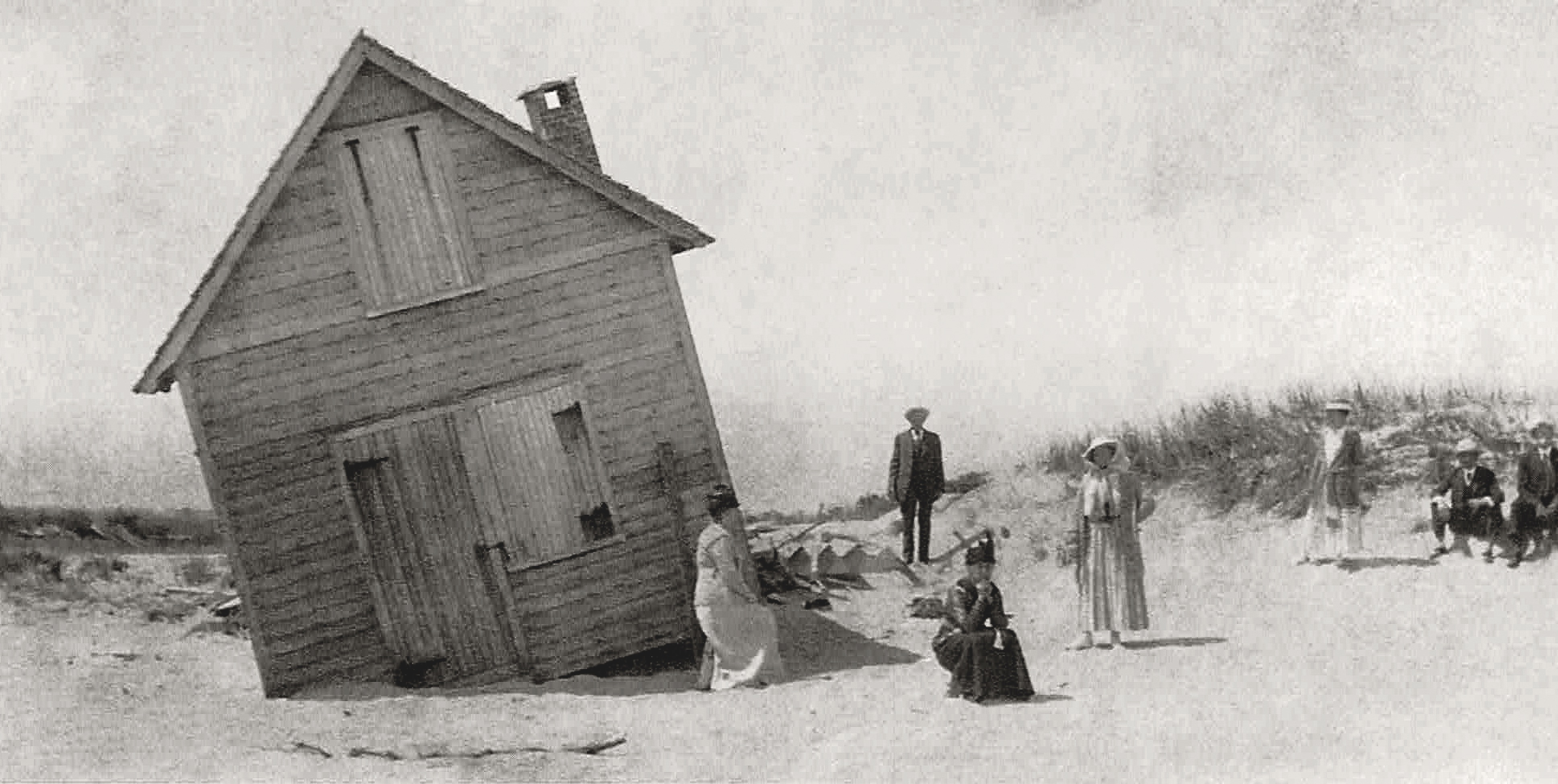
Broadkill Beach retains the quiet charms of an earlier era
By Michael Morgan
Photographs courtesy of the Milton Historical Society
From the April 2022 issue

‘Barefoot Thursday’ was duly celebrated on Broadkiln Beach last Thursday,” the Smyrna Times reported in 1859. “Everyone present on that occasion was obliged to take off his boots and go barefoot. Great country that Sussex! — and great people live ‘thar.’”
Broadkill Beach (or, as it was often called in the 19th century, Broadkiln Beach), with its wide view of Delaware Bay, is washed by that waterway’s gentle waves splashing on replenished sand. Situated on a sliver of shoreline northwest of Lewes, hemmed in by Primehook Beach to the northwest and Beach Plum Island Nature Preserve to the southeast, Broadkill is isolated from crowds, commercial outlets and traffic.
Birds glide past and ships chug by the boardwalk-less beach, where each spring horseshoe crabs stop to mate. Broadkill Beach boasts a single commercial establishment, affectionally known as “The Store.” So, for some, this enclave is primitive; for others, it is merely slow; but to residents and those who frequently visit, it is paradise.
The best day of the week
Early maps show a series of islands along this stretch of Delaware Bay, with the Broadkill River — the suffix “kill” is Dutch for “creek” — following a serpentine route from Milton between two of these small islands and emptying into the bay. Shifting sands closed the openings between the islands to create a long land spit and forcing the river to turn abruptly to the southeast, where it joined the mouth of Lewes Creek (now known as the Lewes-and-Rehoboth Canal) and the Delaware Bay. The former course of the Broadkill is now known as Deep Hole Creek. These changes aside, devotees of the area adjusted so they could enjoy their favorite stretch of sand.
In the 19th century, Milton-area residents came to Broadkill Beach when it was known as a “farmers’ beach” because many of those it attracted worked in nearby fields. It was a time when people went to the beach fully clothed, with men in suits and ties and ladies with ankle-length dresses. To go without shoes was considered daring, but on “Barefoot Thursday” in August, visitors did just that. On that day, according to the Delaware Ledger, whoever “appeared shod was chased, caught and rolled upon the sand until the shoes were removed. The skylarking and frolicking was always good natured and there was no anger nor fighting. A little old peach and apple [liquor] from the Sussex distilleries aided the merriment.”
Visitors to the area never missed a chance for a little merriment, and long ago they also celebrated “Big Thursday” in August to mark the end of a months-long ban on oyster harvesting. In the 19th century, oysters were a ubiquitous part of the American diet, As Harpers New Monthly Magazine noted in 1859, “Oysters [were] pickled, stewed, baked, roasted, fired, and scalloped; oysters made into soups, patties, and puddings; oysters with condiments and without condiments; oysters for breakfast, dinner, and supper; oysters without sting or limit, fresh as the fresh air, and almost as abundant.” There were no oysters better than those from Delaware waters, and like low-flying clouds, the sails of oyster boats covered the bay as harvesters sought the succulent bivalve.
However, the insatiable demand for this product and the efficiency of local watermen led to the depletion of the area’s oyster beds. As a result, in 1852 the state legislature prohibited oystering from May 1 through Aug. 10. During the first year that the restrictions went into effect, Aug. 10 fell on the second Thursday of the month, and on that day, the crews of the oyster boats and their families celebrated the opening of the dredging season. The celebration quickly became an annual event known as “Big Thursday,” with visitors descending on Broadkill Beach to take part. According to the Delaware Gazette and State Journal, “On such occasions hundreds of the ‘rustics’ from miles inland have met in the vicinity of the mouth of the Broadkiln river and indulged in bathing, boating, dancing and occasionally some drunkenness.”
In the late 19th century, these two August celebrations help make Broadkill Beach a viable rival to other seaside resorts, but the popularity of the beaches at Lewes and Rehoboth skyrocketed with the arrival of rail service. Residents of the Milton area, however, remained steadfastly loyal to Broadkill, and many would not even consider going to Rehoboth. For them, Broadkill was “the beach.”
But the serenity that attracted them was threatened when the merchants of Baltimore lobbied Congress to build a ship canal across the Delmarva Peninsula. One of the favored routes was to link the upper reaches of the Choptank River in Maryland to the Broadkill River near Milton and then plow straight through Broadkill Beach to the bay. The proposal spurred one congressional study after another, and it finally died a quiet bureaucratic death.
Beachgoers and bootleggers
While Congress dithered over this plan, residents of Milton and nearby areas continued to take their carriages to the west side of Deep Hole Creek, where a small rowboat carried them to the beach side for a nickel per person. A small power launch was also used for this ferry service, though in 1910 a footbridge was built across Deep Hole Creek. The span — 600 feet long and 4 feet wide — not only allowed access to the beach from the mainland, but it also gave Broadkill Beach a unique architectural feature not found at any other Delaware seaside resort.
In the years before World War I, beachgoers spent their days enjoying the gentle bay waves, fishing for trout, dipping for crabs and raking for oysters and clams. The latter pursuit included unusual methods: In 1916, Broadkiln Neck resident John Wilkins had a collie that would dig out these mollusks. Wilkins claimed that the dog could dig up from one to three bushels of oysters a day.
In the early years of the 20th century, horseless carriages began to bumble along southern Delaware roads and, by the 1920s, vacationers began to drive their cars to Sussex County beaches. The vast majority bypassed Broadkill Beach in favor of the ocean resorts, but with the start of Prohibition, bootleggers discovered the virtues of a quiet resort with few visitors. During the last week of November 1930, a 60-foot vessel, driven by a 400-horsepower engine and loaded with choice liquor for the holiday season, steamed past Cape Henlopen. As the rumrunner approached Broadkill Beach, the boat hit a sandbar. Fearing that the Coast Guard would appear at any moment, the bootleggers threw overboard much of their illicit cargo. Lightened, the boat floated free, the bootleggers went ashore, unloaded their remaining contraband, and fled. When a Coast Guard patrol boat did arrive, the crew retrieved between 140 and 175 cases of alcohol from the bay.
Four-wheeled progress
Although bootleggers may have found the lack of visitors to their liking, the inability of vacationers to drive directly into Broadkill Beach stymied the resort’s growth. In the 1930s, the footbridge was replaced by one for motor vehicles, and access into the resort was finally unhindered. Fortunately for those who enjoyed the area’s quiet nature, Broadkill remained largely unchanged: a small bathing and fishing resort with a line of frame beach cottages strung along the treeless dunes overlooking Delaware Bay. A single street and a single store still served the community. Following a tradition that was decades old, farmers sometimes came to the beach at night with seines to fish, drink and sing until dawn.
The economic downturn that began with the 1929 stock market crash and grew into the Great Depression put a damper on the growth of Delaware’s seaside resorts. The election of Franklin Roosevelt in 1932 set in motion a host of New Deal programs, including the Civilian Conservation Corps. Beginning in December 1933, at the marshes on the west side of Broadkill Beach, an army of CCC workers spent two years cutting ditches that they hoped would rob mosquitoes of their natural habitat. When the project was completed, four companies of the workers gathered near Deep Hole Creek for a ceremony to commemorate the work. With due solemnity, each worker placed a foot square of sod (weighing 35 to 60 pounds) in a circular mound that grew to 6 feet in height and 20 feet in diameter. Each year, the ceremony was repeated to refresh the mound, but the practice was eventually discontinued, and the sod monument withered away.
The Great Depression lasted until the beginning of World War II. When the war began in Europe, American military leaders began a program to improve defenses along the approaches to the mouth of Delaware Bay, and Broadkill Beach was included. To support the guns of Fort Saulsbury farther up the bay near Slaughter Beach, a spotting tower was erected on the marsh side of Broadkill Beach. Although similar in function to the concrete silo-shaped towers that line the beach from Cape Henlopen to Fenwick Island, the Broadkill tower was square and made of steel. Its presence brought the servicemen who manned it and K-9 beach patrols that protected it from saboteurs who might sneak ashore. After the war, the exposed metal of the tower did not weather well, and it was taken down. The only structure still standing as a reminder of when soldiers patrolled the beach is a concrete cable bunker, the size of a backyard shed, that held communication lines to the gun emplacements at Fort Saulsbury.
New homes and sticky buns
The primitive days when beach homes lacked electricity, heat and indoor bathrooms slowly slipped into the past following World War II. As always, however, beach visitors continued to check the direction of the wind. If it was coming from the marshes, aficionados of the bay’s quiet waves had to be prepared for an assault by mosquitoes and biting green-head flies. If the wind was coming in off the bay, all was well.
The postwar development that quadrupled the number of houses at Broadkill Beach was briefly interrupted by the March 1962 storm that cut a temporary inlet near Alabama Avenue. (The inlet was soon filled in by shifting sands.)
In more recent years, those who appreciate the gentle waters, quiet beaches and unobstructed views of passing ships heading to and from Philadelphia have discovered Broadkill Beach, and several large mansions have been built. In the spring, horseshoe crabs continue to mate on this shore, although the main concentration of them occurs north of Slaughter Beach. Beachgoers without shoes are seen every day of the week in the warm months, and “Barefoot Thursday” is no longer celebrated. It has been replaced by “Sticky Bun Tuesday,” when The Broadkill Store serves the specially baked treats.



